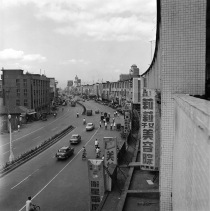|
Tags: culture | street life
|

A villager is selling daily necessities from door to door using a rickshaw to haul his merchandise.
Photo by: GIO Photographer (1952-00-00)
|

Pedicabs were once the main transport in Taiwan’s cities.
Photo by: Transfer from JCRR (Joint Commission on Rural Reconstruction) (1953-00-00)
|

An oxcart is used to transport wood, photographed in 1955. It used to be a main transportation in Taiwan before the railroads were developed.
Photo by: GIO Photographer (1955-00-00)
|
|

The Far East Theater in Taipei is photographed in 1960. Large movie advertisements can be seen atop the movie theater.
Photo by: Transfer from JCRR (Joint Commission on Rural reconstruction) (1960-00-00)
|

Divine figures move to their places for a parade.
Photo by: Transfer from JCRR (Joint Commission on Rural Reconstruction) (1961-00-00)
|

An external view of Taipei’s Chunghua Emporium.
Photo by: Transfer from JCRR (Joint Commission on Rural Reconstruction) (1964-00-00)
|
In the agrarian society of years past, the covered sidewalks in front of shops and the corners of streets where temples, marketplaces, organizations, and railway stations were found were the cradles of Taiwan's street culture that comprised the daily experience of Taiwan's people.
Besides serving a transport-related purpose, the street corner was usually the center of commercial transactions, religious rituals, and recreational activities as well as being the place where the latest political gossip could be shared. People strolled about to purchase daily necessities, engage in people-watching, or simply for the joy of it. These are the collective memory of Taiwan's people.
Before cars and motor scooters, bicycles and three-wheeled pedicabs were the most common form of transport. Imagine this: It's a fine Sunday afternoon in the 1960s. You've just hired a pedicab so that you and your family might go for a ride.
On both sides of the street you see simple snack shops, joss stick and candle shops, teahouses, bamboo-ware shops, ironmongers, herbal medicine shops, as well as fortune-tellers and palm-readers' establishments. Under the red brick archways, there are fruit stands, roadside stalls, and older people sitting and chatting with one another. At the bus stop, people are patiently waiting in line for the bus to come. Occasionally, a private car drives by, catching the attention of all who see it.
In some places, you see sweat-soaked workers who've donned wide-brimmed bamboo hats pushing handcarts slowly past you. There is also an oxcart loaded with timber coming your way or a pedicab carrying piglets on its way to the marketplace. You may also see a water truck sent by the township office, sprinkling water on the asphalt street to cool it down.
A while later, the sound from a loudspeaker is getting louder and louder. It is a movie theater's advertising pedicab inviting people to see a new film. Hawkers pull an assortment of carts laden with various sundry articles and daily necessities on major streets and in narrow alleys. The articles they offer range from large trays made of bamboo, laundry poles, and feather dusters to brushes made of pig bristles. Everything you could possibly want is to be found on their carts.
Arriving at the streets where the hawkers gather, there are peddlers selling popsicles and ice cream and sellers of grilled sausages, grilled corn, sugary roasted chestnuts, and steamed water chestnuts. It's enough to make your mouth water. Not far away, you see a crowd circled around something. Inside the circle, a man is wielding a big knife as an advertisement for his products—salves to treat all kinds of injuries.
On the corner, there is a small apparel and footwear-repair store, and near it people are crouched around a newsstand thumbing through magazines. You wander to the end of the street, where you come upon a temple's courtyard and hear the din of a string of exploding firecrackers. It heralds a temple event for General Fan and General Hsieh, in which gongs and drums raise a racket and two men wearing oversized masks and robes posing as the deities traipse theatrically down the street.
The fun and leisure of life in these old streets have gradually disappeared in the forest of tall vehicles, the din of motor vehicles, and the busy traffic on thoroughfares, all of which are the byproducts of prosperity. These scenes have long faded into memory.
But in recent years, with the government's push to develop communities, people have begun to move out of the concrete jungle and return to the peaceful tree-shaded streets to sunbathe or take a bicycle ride or a stroll—simply to relive the wonderful life experiences they enjoyed in the past.
Taiwan Image - Photo Archive
Text and images are provided by Ministry of Foreign Affairs, Republic of China (TAIWAN)
|

















